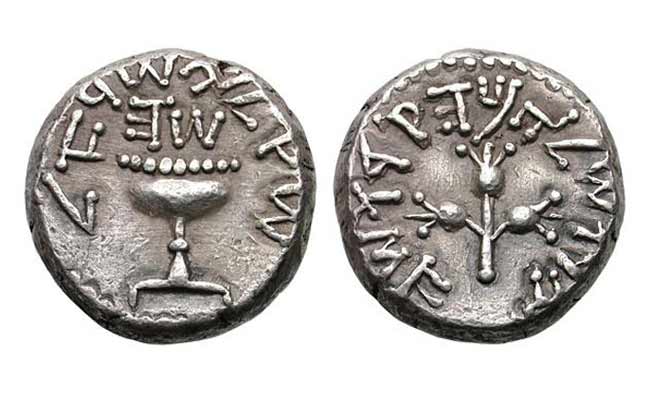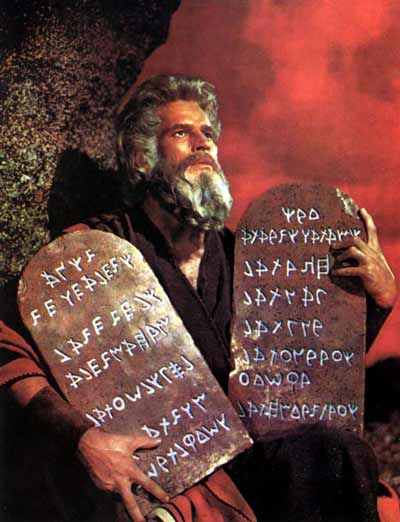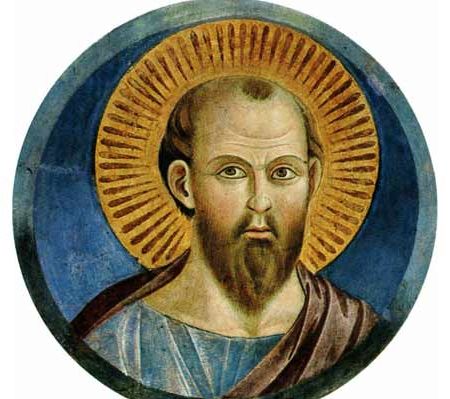
Coin of the Jewish revolutionary
resistance to Rome
Neil Faulkner Archive | ETOL Main Page
Marxist History
Published online by Counterfire, 8 November 2010.
Copied with thanks from the Counterfire Website.
Marked up by Einde O’Callaghan for the Encyclopaedia of Trotskyism On-Line (ETOL).
Neil Faulkner examines how the three great monotheistic religions produced by the contradictions of the ancient world owed their extraordinary power to their origins in the myths and rituals of the oppressed.
 Coin of the Jewish revolutionary |
In 537 BCE (before the common era), Cyrus the Great, the new Persian ruler of Babylonia (modern Iraq), granted the descendants of a group of Jewish aristocratic exiles permission to ‘return’ to their homeland. Cyrus wanted loyalists in control of newly-conquered imperial territory. The Jewish ‘exiles’ aspired to become a new ruling class.
The Return from Babylonian Captivity is one of the central events in the Judaeo-Christian historical tradition. The reality was that the Jewish elite was replanted in Palestine as the quisling administration of an imperial superpower.
They brought with them an ideological powder-keg. Forged in decades of disunity, defeat, and dispersal, the Jewish cult of a supreme power-deity, Yahweh, had morphed into an intolerant monotheism that denied the existence of all other gods.
In the past, the Jewish prophets had railed in vain against false idols. Now, the frustrated nationalism of an exiled leadership found expression in Yahweh’s claim to worldwide dominion. Political impotence found its religious alter-ego in divine megalomania.
If, instead of a pantheon of warring deities, there was one all-powerful god, then history moved to a single divine purpose, and those chosen for God’s special favour, as long as they remained loyal and obedient, were bound to win out in the end.
 Moses: a Jewish nationalist myth of the |
The myth of Moses – essentially a 6th century BCE construct – was the belligerent response of hardcore nationalists to their own weakness and fragmentation. The whole of Jewish history was rewritten in the light of new religious ‘truths’. The one and only god was Yahweh. The Jews were his Chosen People. And Palestine was their Promised Land.
But this was the view only of a marginal sect, a small exile group whose restorationist ambition took the form of religious fantasy. Alone, they could have done nothing but hope and pray. It was Persian imperialism that lifted them from historical oblivion and placed them on a global stage. It was Cyrus the Great who planted the New Judaism in Palestine and allowed it to blossom.
It proved to be a complex hybrid. The Jews were an embattled minority, overshadowed by greater peoples – the Persians, the Greeks, and the Romans. Palestine was a small country, occasionally capable of precarious independence, more usually subordinate to a foreign empire.
The Jewish aristocracy was torn between fighting for independence and collaborating with imperialism. The risks of fighting were high. Defeat could mean losing everything, but so could victory – if mass mobilisation to fight for independence conjured a popular revolutionary movement from below.
The Jewish peasantry was also torn – between fear of authority, a sense of powerlessness, and a deep-rooted hatred of the exploiter.
So Judaism splintered into rival sects, some aristocratic and collaborationist, others popular, radical, and calling openly for resistance.
Judaism welded the Jewish masses into a powerful revolutionary force on at least four occasions. When a Seleucid Greek king attempted to replace the worship of Yahweh with that of Zeus, he provoked nationwide resistance. The Maccabaean Revolt of 167–142 BCE eventually secured an independent Jewish state.
As Roman rule tightened, the Jews rose in revolt three more times, in 66–73, in 115–117, and in 132–136 CE (common era). Each time, the fighting was long, hard, and murderous. Each time, tens of thousands were killed, hundreds of thousands displaced.
The final revolt was suppressed with such genocidal ferocity that the Jewish population was cut to a fraction of what it had been. Thereafter, the ten million Jews of the ancient world were almost entirely a people of the diaspora, living mainly in urban ghettos across the eastern Mediterranean.
Among those involved in the Jewish anti-imperialist movement was a preacher from Nazareth called Jesus. A charismatic radical, he attracted a growing following among the village poor, so he was arrested, tried, and executed. The group he had founded survived as a small sect. But it soon split into two distinct tendencies.

St Paul, who invented Christianity by reinterpreting |
One tendency remained committed to the Jewish national-revolutionary movement. This group was destroyed in the defeat of the First Jewish Revolt of 66–73 CE. The other tendency, led by Paul of Tarsus, a Hellenised Jewish merchant, detached itself from the movement and adopted a conservative ideology of spiritual – not material – redemption. And this, the Pauline Christians argued, was a message not just for Jews, but for humanity as a whole.
The New Testament – which records the mission of Jesus and the early history of the Church – is a work of revisionism, written by Pauline Christians of the Jewish diaspora in the aftermath of the defeat of the First Revolt. Jesus, it turned out, was both a man and a god, his kingdom was not of this earth but of heaven, and his message was universal and spiritual rather than Jewish-revolutionary.
The gospel writers created a de-politicised and de-nationalised Jesus capable of surviving the raging ‘war on terror’ which swept the Roman Empire in the wake of the Revolt.
Something of the original yet remained. In a way that the awesome power-deities of the pagan pantheon could not, the all-powerful and supremely benevolent Christian god offered ‘a heart in a heartless world’ that had strong appeal to the oppressed of the Roman Empire.
Pauline Christianity was a potent synthesis. It represented a fusion of Jewish prophecy and popular preaching with an essentially Greek tradition of salvation cult. Jesus the Jewish prophet was transformed into Jesus the universal saviour-god.
To this were added two distinctively Christian elements, both derived from the religion’s roots in the Jewish revolutionary movement: in contrast to the rigid class hierarchies of Roman society, the idealisation of an egalitarian and democratic community; and instead of the selfishness, greed, and violence legitimised by mainstream paganism, an emphasis on caring, compassion, and co-operation.
The exploitation and oppression of the Roman Empire meant misery for millions, but the violence of the state usually prevented effective resistance. This was the contradiction that allowed the Christian Church to grow and grow.
 State terror failed to break the Early Christian Church |
Recruiting among slaves, women, and the poor, the Church was viewed with grave suspicion, and was repeatedly battered by repression. It not work. The men and women set on fire, eaten alive by animals, or nailed onto wooden crosses to die provided the Early Church with a roll call of martyrs as impressive as any in history.
By the early 4th century CE, the Church had become the most powerful ideological apparatus in the Mediterranean world, with a complete underground network of priests, congregations, and meeting-places extending across the Empire.
Many army officers, government officials, and wealthy landowners had already become Christians. In 312 CE, the Emperor Constantine the Great decided to adopt Christianity himself, to legalise the religion, and to make the state the protector and patron of the Church. Before the century was out, his successor, Theodosius the Great, would make paganism illegal and hand over all temple estates to the Church.
Judaeo-Christian monotheism was now recast as an ideology of state-power, empire, and war. The Roman emperor became, at once, a defender of civilisation against barbarism, a crusader for the Church against heathens, and a champion of orthodoxy against heretics.
Christianity was fragmented, as Judaism had been, by the social contradictions it encompassed. Competition between rival factions and states, and tensions between antagonistic classes, destroyed the ideal of a single, universal Church.
The division between the Eastern and Western Roman Empires – final after 395 CE – was mirrored in the separation of the (eastern) Orthodox and (western) Catholic traditions. The class struggle between landlords and peasants found expression in the split between Donatist and Catholic Churches in North Africa.
Every group, each pursuing different and conflicting aims, claimed the one all-powerful god as ally. At its most extreme, the ideological ferment could produce entirely new offspring, as Judaism had brought forth Christianity. One such development was destined to produce another great world religion.
From the cultural melting-pot of two Arabian caravan-cities, where ancient pagan traditions from the desert mixed with versions of Judaeo-Christian faith, came another revolutionary synthesis: Islam.
Neil Faulkner Archive | ETOL Main Page
Eleven Reasons to Fight
Last updated on: 14 February 2022